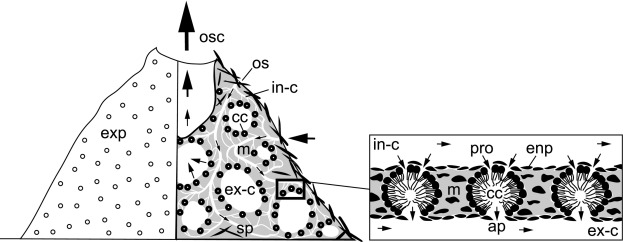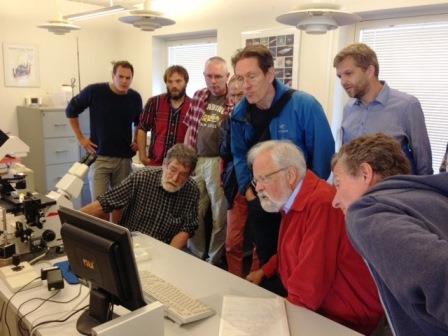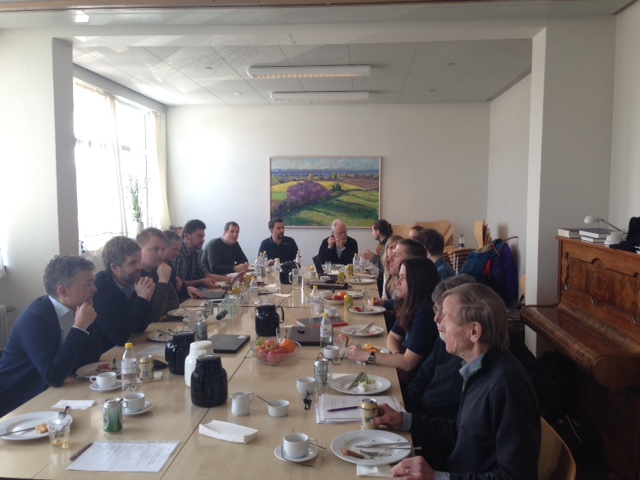Supported by a grant (no. 9278) from VILLUM FONDEN (6,398,350 DKR in the period September 2015 to September 2019)
Participants: Hans Ulrik Riisgård, Don Canfield, Niels T. Eriksen, Peter Funch, Poul Scheel Larsen, Jens H. Walther, Knud Erik Meyer, Tom Fenchel, Claus Nielsen, Ana Riesgo, Gert Wörheide
Abstract: Sponges are one of the earliest evolved, and simplest, groups of animals. They are multicellular but lack the typical organization of other animals with e.g. anterior-posterior polarity and nerves. Sponges are sessile animals with water-pumping choanocyte chambers. They share a number of characteristics with other filter-feeding animals. However, they also share characteristics with choanoflagellates, a group of filter feeding flagellates believed to be the sister group to all animals including sponges; they are not ancestral as such, but share a common ancestor. In this project we will study the bioenergetics and bio-fluid mechanical properties of free-living choanoflagellates, colonial choanoflagellates and sponges. Our goal is to investigate, elucidate and quantify the major differences in functional biology of unicellular choanoflagellates and multicellular sponges in order to identify the evolutionary steps that enabled the development of multicellular sponges in which the entire body is specialized for filter-feeding, and to therefore understand a critical step in the history of animal evolution. The project is focused on comparative morphology combined with experimentally measured bioenergetic parameters, including filtration, respiration, particle capture efficiency, food ingestion and excretion in sponges and choanoflagellates. Bio-fluid mechanical studies will also play a central role in the project where we will track particle motion and flow fields around free-swimming choanoflagellates, colonies of choanoflagellates, and the internal water flows through sponge canals and filters. We will also explore the mixing created by exhalant jet-currents from the sessile sponge colonies. Observations will lead to detailed biophysical models explaining the flow patterns and dynamics of food capture in all of the studied organisms. Finally, we want to explore the origin and evolution of a multicellular water-pumping sponge from a phylogenetic point of view.

Schematic representation of the water flow (arrows) through the aquiferous system of a partially sectioned breadcrumb sponge (Halichondria panicea) with a single osculum (osc).Left: the external sponge surface is composed of an epithelium called exopinacoderm (exp) with open pores called ostia (os; open circles) through which water is drawn into the sponge. Center: external part removed to show the internal incurrent (in-c) and excurrent canals (ex-c) both lined with endopinacoderm (enp); choanocyte chambers (cc; black circles) are composed of flagellated cells called choanocytes which drive the water current. The mesohyl (m) is a region of the sponge situated between the external pinacoderm and the internal aquiferous system with mobile cells and skeletal material called spicules (sp). Right: Magnified view of the flow direction (arrows) through choanocyte chambers. Water is pumped from the incurrent canal into the chambers through prosopyles (pro) by means of the beating flagella of choanocytes and exits into an excurrent canal through an apopyle (ap). From: Riisgård et al. (2023)
Halichondria panicea. Live-cell imaging of a choanocyte chamber (CC) in a sponge sandwich culture using transmitted brightfield microscopy (Nikon Eclipse Ti-E with Nikon Plan Apo 60× NA 1.4 oil objective, frame rate: 60 fps). Choanocytes with their beating flagella are visible. sp: spicule. From: Riisgård et al. (2023)
Publications
Publications from VILLUM FONDEN sponge project (2015-2019), inclusive of BSc, MSc & PhD thesis
Asadzadeh, S.S., Nielsen, L.T., Andersen, A., Dölger, J., Kiørboe, T., Larsen, P.S., Walther, J.H. (2019). Hydrodynamic functionality of the lorica in choanoflagellates. J. R. Soc. Interface 16(150): 20180478. https://doi.org/10.1098/rsif.2018.0478
Asadzadeh, S.S., Larsen, P.S., Riisgård, H.U., Walther, J.H. (2019). Hydrodynamics of the leucon sponge pump. J. R. Soc. Interface 16(150): 20180630. https://doi.org/10.1098/rsif.2018.0630
Asadzadeh, S.S. (2019). Numerical and experimental study of flow in choanoflagellates and choanocytes. PhD thesis, DTU Copenhagen.
Bisbo, N. (2017). A study on the functional morphology of the pump and filtration apparatus of the marine demosponge, Halichondria panicea. BSc thesis, Aarhus University.
Bisbo, N. (2019). The phylogeny of Demospongiae (Porifera) in the light of the functional morphology of the aquiferous system. MSc thesis, Aarhus University.
Busk, T. (2018). Filtration rates in single-osculum sponge explants, with emphasis on the importance of osculum and sponge module size. BSc thesis, University of Southern Denmark.
Callesen Madsen, J. (2019). Unintentional movement of sponge species through marine ornamental trade. BSc thesis, Aarhus University.
Eriksen, N.T., Tophøj, J., Wollenberg, R.D., Søndergaard, T.E., Funch, P., Andersen, P. (2019). Growth and single cell kinetics of the loricate choanoflagellate Diphanoeca grandis. Sci. Rep. 9(1): 14543. https://doi.org/10.1038/s41598-019-50998-0
Fenchel, T. (2017). The Choanoflagellates: Evolution, Biology and Ecology. By Barry S. C. Leadbeater. Cambridge and New York: Cambridge University Press. $125.00. xiii + 315 p.; ill.; choanoflagellate species index, other species index, general index. ISBN: 978-0-521-88444-0. 2015. Q. Rev. Biol. 1. https://doi.org/10.1086/690889
Fenchel, T. (2019). Filter-feeding in colonial protists. Protist 170: 283-286.
Frilund, J. (2017). Comparison of Km values between sponges and the choanoflagellate Salpingoeca rosetta. BSc thesis, University of Southern Denmark.
Gadour, M. (2019). Contractile behaviour of the demosponge Halichondria panicea due to overloading with re-suspended sediment. MSc thesis (ERASMUS), University of Nantes.
Goldstein, J., Riisgård, H.U., Larsen, P.S. (2019). Exhalant jet speed of single-osculum explants of the demosponge Halichondria panicea and basic properties of the sponge-pump. J. Exp. Mar. Biol. Ecol. 511: 82-90. https://doi.org/10.1016/j.jembe.2018.11.009
González-Aravena, M., Kenny, N.J., Osorio, M., Font, A., Riesgo, A., Cárdenas, C.A. (2019). Warm temperatures, cool sponges: the effect of increased temperatures on the Antarctic sponge Isodictya sp. PeerJ 7: e8088. https://doi.org/10.7717/peerj.8088
Halldorson, A.O. (2018). Fluid dynamics of sea sponges: Estimating exhalant jet velocity under varying ambient flow velocity. MSc thesis, DTU Copenhagen.
Hansen, K.H. (2017). Sensitivity of the demosponge Halichondria panicea to laboratory versus field conditions, using filtration activity as indicator. BSc thesis, University of Southern Denmark.
Kealy, R.A., Busk, T., Goldstein, J., Larsen, P.S., Riisgård, H.U. (2019). Hydrodynamic characteristics of aquiferous modules in the demosponge Halichondria panicea. Mar. Biol. Res. 15(10): 531-540. https://doi.org/10.1080/17451000.2019.1694691
Kealy, R.A. (2017). Contraction-inflation behavior of small single-osculum explants of the demosponge Halichondria panicea – a mechanism to protect the sponge filter-pump? MSc thesis, University of Southern Denmark.
Keller Lees, M. (2019). Capture and translocation of microplastic particles in the aquiferous system of the marine demosponge Halichondria panicea. BSc thesis, University of Southern Denmark.
Kumala, L., Riisgård, H.U., Canfield, D. (2017). Osculum dynamics and filtration activity in small single-osculum explants of the demosponge Halichondria panicea. Mar. Ecol. Prog. Ser. 572: 117-128. https://doi.org/10.3354/meps12155
Kumala, L., Canfield, D.E. (2018). Contraction dynamics and respiration of small single-osculum explants of the demosponge Halichondria panicea. Front. Mar. Sci. 5: 410. https://doi.org/10.3389/fmars.2018.00410
Larsen, J.M.D. (2017). Contraction-inflation behavior of small single-osculum explants of the demosponge Halichondria panicea − a mechanism to protect and clean the sponge filter-pump? BSc thesis, University of Southern Denmark.
Lüskow, F., Riisgård, H.U., Solovyeva, V., Brewer, J.R. (2019). Seasonal changes in bacteria and phytoplankton biomass control the condition index of the demosponge Halichondria panicea in temperate Danish waters. Mar. Ecol. Prog. Ser. 608: 119-123. https://doi.org/10.3354/meps12785
Lüskow, F., Kløve-Mogensen, K., Tophøj, J., Pedersen, L.H., Riisgård, H.U., Eriksen, N.T. (2019). Seasonality in lipid content of the demosponges Halichondria panicea and H. bowerbanki at two study sites in temperate Danish waters. Front. Mar. Sci. – Aquatic Physiology 6: 328. https://doi.org/10.3389/fmars.2019.00328
Mills, D.B., Canfield, D.E. (2017). A trophic framework for animal origins. Geobiology 15(2): 197-210. https://doi.org/10.1111/gbi.12216
Mills, D.B., Francis, W.R., Vargas, S., Larsen, M., Elemans, C.P.H., Canfield, D.E., Wörheide, G. (2018). The last common ancestor of animals lacked the HIF pathway and respired in low-oxygen environments. eLIFE 7: e31176. https://doi.org/10.7554/eLife.31176.001
Mills, D.B., Francis, W.R., Canfield, D.E. (2018). Animal origins and the Tonian Earth system. Emerg. Top. Life Sci. 2(2): 289-298. https://doi.org/10.1042/ETLS20170160
Myrhøj Jensen, R. (2019). Changes in bacterial community composition in developing explants of the demosponge Halichondria panicea. BSc thesis, Aarhus University.
Nielsen, L.T., Asadzadeh, S.S., Dölger, J., Walther, J.H., Kiørboe, T., Andersen, A. (2017). Hydrodynamics of microbial filter feeding. Proc. Natl. Acad. Sci. U.S.A. 114(35): 9373-9378. https://doi.org/10.1073/pnas.1708873114
Petersen, S.R. (2017). Flow measurements on sea sponges. BSc thesis, DTU Copenhagen.
Plese, B., Rossi, M.E., Kenny, N., Taboada, S., Koutsouveli, V., Riesgo, A. (2019). Trimitomics: An efficient pipeline for mitochondrial assembly from transcriptomic reads in non-model species. Mol. Ecol. Resour. 19(5): 1230-1239. https://doi.org/10.1111/1755-0998.13033
Riisgård, H.U., Kumala, L., Charitonidou, K. (2016). Using the F/R -ratio for an evaluation of the ability of the demosponge Halichondria panicea to nourish solely on phytoplankton versus free-living bacteria in the sea. Mar. Biol. Res. 12(9): 907-912. https://doi.org/10.1080/17451000.2016.1206941
Roulund Buur, L. (2019). Filter-feeding behaviour, growth and bioenergetics of the demosponge Halichondria panicea, with focus on a possible energy-saving mechanism during low-food periods. MSc thesis, University of Southern Denmark.
Taboada, S., Silva, A.S., Neal, L., Cristobo, J., Ríos, P., Alvarez-Campos, P., Hestetun, J.T., Koutsouveli, V., Sherlock, E., Riesgo, A. (2020). Insights into the symbiotic relationship between scale worms and carnivorous sponges (Cladorhizidae, Chondrocladia). Deep Sea Res. Part I Oceanogr. Res. Pap. 156: 103191. https://doi.org/10.1016/j.dsr.2019.103191
Tophøj, J., Wollenberg, R.D., Søndergaard, T.E., Eriksen, N.T. (2018). Feeding and growth of the marine heterotrophic nanoflagellates, Procryptobia sorokini and Paraphysomonas imperforata on a bacterium, Pseudoalteromonas sp. with an inducible defence against grazing. PLoS ONE 13(4): e0195935. https://doi.org/10.1371/journal.pone.0195935
Tophøj, J. (2017). Growth studies and isolation of four heterotrophic flagellates. MSc thesis, Aalborg University. Asadzadeh SS, Kiørboe T, Larsen PS, Leys SP, Yahel G, Walther JH (2020) Hydrodynamics of sponge pumps and evolution of the sponge body plan. Elife 9: e61012 https://doi.org/10.7554/eLife.61012
Working notes
Tom Fenchel: “Suspension feeding and colony formation in choanoflagellates and in peritrich ciliates”
LOGIN area
To access these documents contact Hans Ulrik Riisgård (hur@biology.sdu.dk) for password.
Participants
- List of participants (30 December 2016)
- List of participants (28 November 2017)
- List of participants (12 April 2018)
- List of participants (10 November 2018)
2015
1. Project description, application documents, granting letter
- Project description
- Budget (application)
- Appendix (supporting letter)
- Granting letter (from VILLUM fonden)
2. Preparatory meeting in Kerteminde – 10 April 2015
- Agenda for preparatory sponge meeting 10 April 2015 (in Danish)
- Collaborative agreement (fully signed)
- Power-point presentation by Lars Kumala
- Picture of hollow colony of Diaphanoeca spherica
- Power-point presentation by Dan Mills
3. Kick-off meeting in Kerteminde – 28 August 2015
- Note on Codosiga botrytis by Tom Fenchel (in Danish)
- Resume from kick-off sponge project meeting
- WP1 Power-point presentation by Lars Kumala
- WP2 Power-point presentation by Dan Mills
- WP3 Power-point presentation by Niels T. Eriksen
- WP4 Power-point presentation by Peter Funch
- WP5 Power-point presentation by Jens Walther


Inspection of sponge-project facilities at the Fjordlab in Kerteminde 10 April 2015


Sponge-meeting participants fascinated by Codosiga gracilis presented by Tom Fenchel at the Fjordlab in Kerteminde 28 August 2015
2016
4. Annual meeting at DTU Copenhagen – 4 March 2016
- Programme and list of participants at DTU
- Social part: Hotel Fortunen
- WP1 & WP2 Power-point presentation by H.U. Riisgård & Don Canfield
- WP3 Power-point presentation by Niels T. Eriksen
- WP4 Power-point presentation by Peter Funch
- WP5 Power-point presentation by Jens H. Walther
- Note on Codosiga by Tom Fenchel
- WP6 Power-point presentation by Gert Wörheide & Ana Riesgo
5. Annual progress report for 2015
6. Sponge-project meeting in Kerteminde – 28 October 2016
- Minutes of meeting (updated 30 December 2016)
- List of participants
- WP1 & WP2
- WP3 (to come?)
- WP4
- WP5
- WP6 (to come?)
7. Annual progress report for 2016 (submitted to VILLUM FONDEN 28 March 2017)
2017
8. Spring sponge-project meeting in Aarhus – 24 April 2017
Aarhus University, Bioscience, building 1540, room 229, Ny Munkegade 114, 2nd floor, 10:00 am – 3:30 pm
- Invitation
- Programme
- Presentation WP1a
- Presentation WP1b
- Presentation WP2
- Presentation WP3
- Presentation WP4a
- Presentation WP4b
- Presentation WP5a
- Presentation WP5b
- Presentation WP6

Refreshments after the sponge-project meeting in Aarhus 24 April 2017

Knud Erik Meyer and Sarah Rurup Petersen from DTU conducting flume studies on sponge explants in Kerteminde 31 May 2017
9. Fall sponge project-meeting in Odense – 26 October 2017
University of Southern Denmark (SDU), Campus Kollegiet, Campusvej 1, 14. Floor, Sky
- Minutes of meeting
- Collaboration between WPs
- List of participants
- “The Choanoflagellates: Evolution, Biology and Ecology”
- NEXT SPONGE MEETING: 12 April 2018
10. Annual progress report for 2017 (submitted to VILLUM FONDEN 26 February 2018)
2018
11. Sponge meeting in Kerteminde – 12 April 2018
- Programme
- List of participants
- Presentation WP1a
- Presentation WP1b
- Presentation WP1c
- Presentation WP3a
- Presentation WP3b
- Presentation WP4
- Presentation WP5a
- Presentation WP5b
- Minutes of meeting

Sponge meeting in Kerteminde 12 April 2018
12. Sponge meeting in Odense – 28 September 2018
- Programme
- List of participants
- Presentations WP1
- Presentation WP3
- Minutes of meeting
- NEXT SPONGE MEETING: 05 April 2019 in Aalborg, hosted by Niels T. Eriksen (WP3)
2019
13. Sponge meeting in Aalborg – Friday 05 April 2019
Hosted by Niels T. Eriksen, Aalborg University, Dept. of Chemistry and Bioscience, Fredrik Bajers Vej 7H, Room 2.403-9, 9220 Aalborg Ø (GPS-coordinates: 57°0’52.8″N 9°59’6.4″E)
- Programme
- 10:30-11:00 Arrival & coffee
- 11:00-12:30 Welcome and presentations from WP1 –WP3
- 12:30-13:00 Lunch
- 13:00-16:00 Presentations from WP4-WP6
- 16:00-16:30 Steering group meeting (WP leaders)
- Evening program (to come)
- Minutes of meeting
